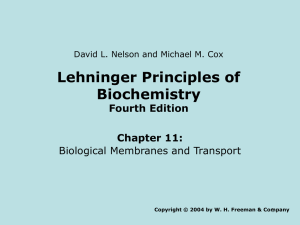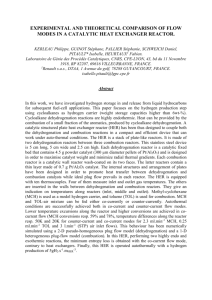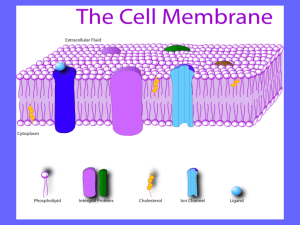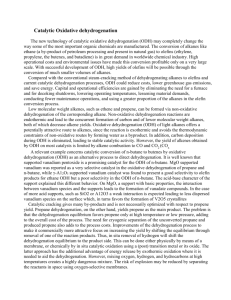MIECs Membrane reactors
advertisement
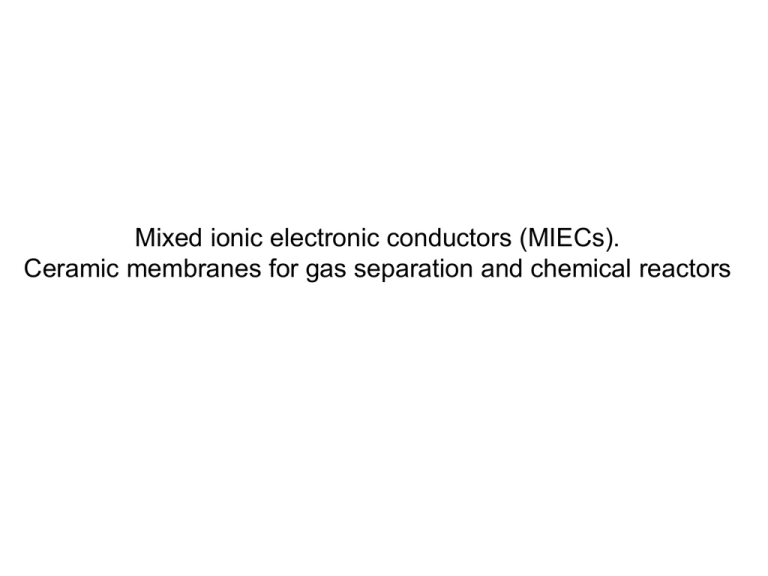
Mixed ionic electronic conductors (MIECs). Ceramic membranes for gas separation and chemical reactors MIECs Membrane reactors Dense ceramic membranes made of MIECs have attracted interest for the realization of membrane reactors. >Mass transport by ionic diffusion through the lattice + electronic conductivity for charge compensation >Superior chemical and thermal stability in comparison to polymeric membranes; >High selectivity for oxygen and hydrogen separation; >Production of pure oygen, enriched air, hydrogen; membrane >Selective oxidation of hydrocarbons (uniform and well-controlled O2 flux); reactors >Splitting of oxygen containing molecules (H2O, N2O, NOx) >High fluxes; >Scalability of reactors; >Cost reduction and energy saving; MIEC membrane MIECs d Transport process Mass flux in a chemical potential gradient J O2 Ji ' RT 1 pO 2 driving force amb ln '' 2 16 F d pO 2 thickness amb e ion e ion If e>> ion amb = ion ion Di ci di RT dx Wagner equation 2 O 4F V DV RT Vm DV A exp Ea / RT If the diffusion rate is very high (d < dc), surface oxygen exchange reactions become rate controlling. dc ion: ionic conductivity; e : electronic conductivity; Dv: VO diffusion coefficient; Vm: molar volume DO ks ks = surface exchange reaction constant MIECs Materials Most used MIECs are ABO3 perovskites with general composition BaCoxFeyZrzO3– (x+y+z=1) or La1-xSrxCoxFe1-xO3-. 1250K 1000K 830K P P B P Bi2O3-based (B) P P C Ceria-based (C) B B B B Perovskites (P) MIECs Materials 900°C, 100 m BaCoxFeyZrzO3– MIECs Materials Chemical expansion of perovskites Formation of additional oxygen vacancies at high temperature produces an increase in thermal expansion. Compatibility problems. Same or similar material for the support porous tube and active dense membrane. A0.68Sr0.3Co0.2Fe0.8O3−δ Slope change MIECs Tubular membranes Activation layer Dense layer Porous support layer Ba0.5Sr0.5Co0.8Fe0.2O3−δ MIECs Membrane module design Planar design Tubular design MIECs Applications: oxygen separation (1) Using a sweep gas (steam) (2) Two-step process 5 bar 50% O2 Oxygen production: 10 mL cm-2 min-1 at 900°C MIECs Applications: dehydrogenation of light alkanes (1) Conventional catalytic thermal dehydrogenation of light alkanes suffers from low alkane conversion due to thermodynamic limitation. alkane alkene H 2 G0 0 (2) Oxidative dehydrogenation of alkanes improve conversion efficiency but leads to byproducts. Steam suppresses coke formation. 1 H 2 O2 H 2O 2 G 0 220 kJ / mol Use of MIEC membranes allows for the controlled supply of oxygen (no co-feeding) leading to high selectivity and can exploit the advantages of both methods by realizing a sequence of thermal dehydrogenation/oxydative dehydrogenation steps. O2 permeable membrane Passivated membrane DH: dehydrogenation HC: hydrogen combustion MIECs Applications: dehydrogenation of light alkanes Literature: conventional catalytic reactor ethene propene MIECs Applications: hydrogen production from water splitting Water splitting coupled with syngas or alkene production Water splitting Syngas production Alkene production 1 H 2 O2 H 2O 2 G 0 220 kJ / mol The reaction is shifted to the right even at high temperature. To increase H2 production rate, p(O2) must be very low at the opposite side of the membrane by means of an oxidation reaction. H2 production 3.1 mL cm-2 min-1 at 950°C
